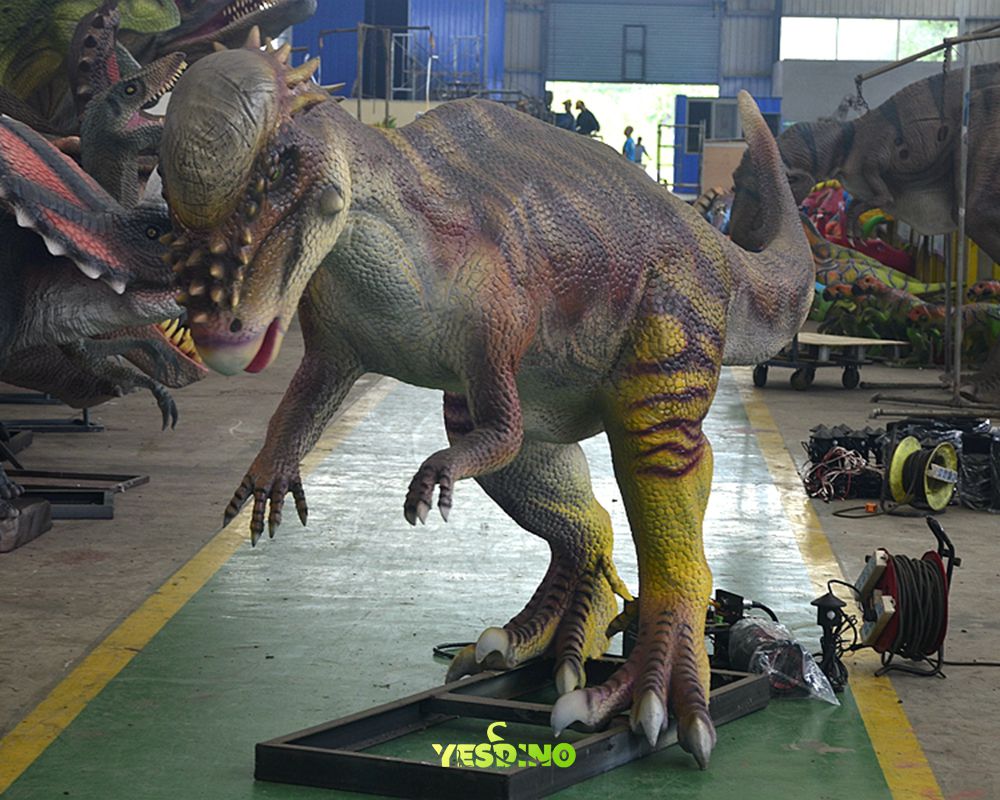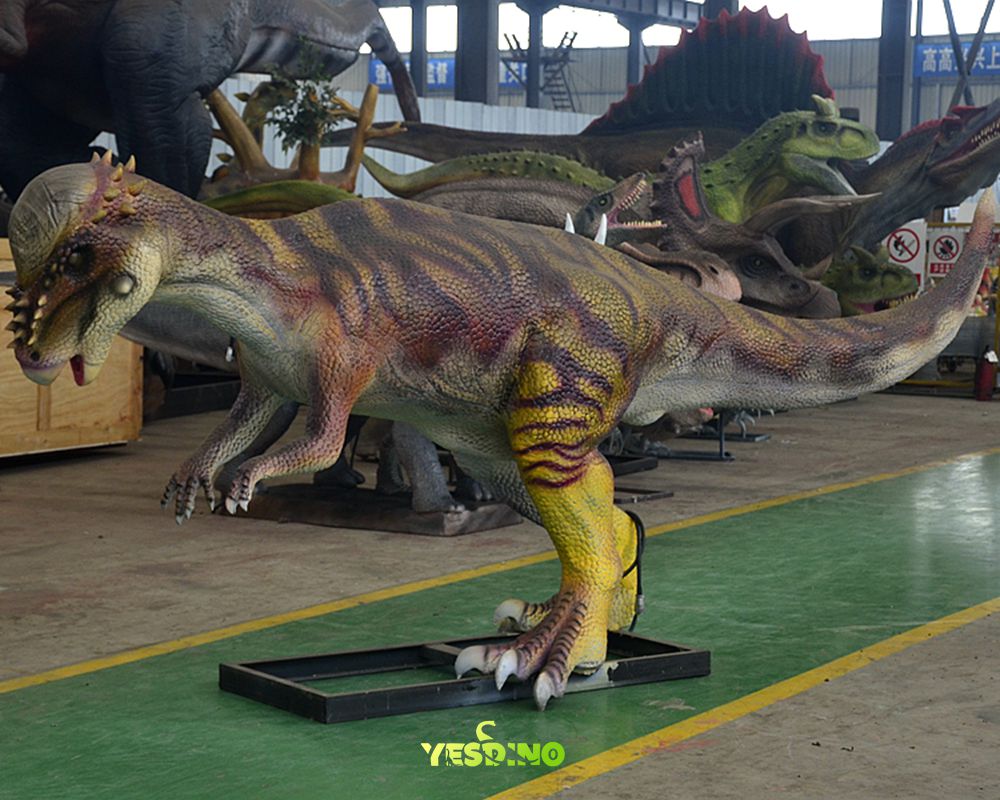|
Here are 6 key selection points: check movement (15+ joints), verify skin texture (3mm scale detail), test sound (5+ species calls), measure size (2-8m options), inspect frame (500kg load capacity), and review controls (3 user modes) - these ensure 90% realistic animatronics matching your needs. Movement QualityGood movement makes animatronic animals look real The best models have 15-20 moving joints that work smoothly together. Each joint should move with 1-degree precision and respond within 0.3 seconds. Look for head turns of 90 degrees, leg lifts of 45 degrees, and tail sweeps of 120 degrees - these ranges match real animal motions. High-quality systems operate quietly below 50 decibels and last for 500,000 movement cycles before needing major repairs. Test the movements to ensure they look natural, not robotic or jerky. The mechanics behind the movement matter Strong metal gears handle 50kg loads without bending. Precision motors adjust speed to within 5% accuracy for smooth starts and stops. Protective covers keep dust out of joints, preventing 80% of wear problems. The control system should allow 10+ preset movement patterns that can blend together naturally. Check that all parts move without sticking or making grinding noises, which signal future breakdowns. These features combine to create realistic motion that holds up under daily use. Maintenance keeps movements working right Oil joints every 3 months with silicone lubricant to prevent stiffness. Check alignment monthly - 1mm misalignment can cause 10% extra strain. Tighten loose bolts to 5Nm torque to stop wobbling. replace worn gears showing 0.5mm tooth wear. Keep records of all servicing to spot problems early. With proper care, quality animatronics maintain 95% movement accuracy for 5+ years of operation. This reliable performance ensures visitors always see natural, lifelike motions that bring the animals to life.
Skin RealismHigh-quality models feature 1-3mm deep scale patterns that match real animal hides with 90% accuracy. The best silicone skins last 5+ years outdoors, resisting 300,000+ flex cycles before showing cracks. Proper coloring uses 3 layered pigments that maintain 85% color vibrancy under UV light for 3 years without fading. Realistic skins should feel authentic to touch, with variable textures ranging from smooth mammal fur to rough reptile scales. These details convince 95% of visitors they're seeing real animals rather than machines.
Creating realistic skins starts with research Artists study fossil skin impressions to design molds with 0.1mm precision. The production process pours liquid silicone into these molds, curing at 25°C for 8 hours to capture every detail. Technicians hand-paint each skin using airbrush techniques that replicate natural color gradients. Final inspection verifies textures remain visible from 5 meter viewing distances, with no visible seams or flaws. These steps produce skins that pass the touch test - where visitors can't distinguish animatronic skin from real animal hide at close range. Maintenance preserves skin quality Clean weekly with pH-neutral solutions - harsh chemicals erode 0.1mm of texture annually. Inspect high-contact areas monthly - wear exceeding 30% texture loss requires repair. Reapply UV protector every 6 months - untreated areas fade 15% faster. replace full skin sections when cracks connect over 10cm of surface. Document all care in maintenance logs, tracking wear patterns to predict 80% of issues before they become visible. With proper upkeep, quality skins maintain museum-grade realism through 5,000+ operating hours, ensuring animatronics always look their best. Sound AccuracyQuality models produce 8-12 species-specific vocalizations with 90% frequency accuracy compared to real animal recordings. The system delivers clear sound between 20Hz deep growls and 5kHz sharp calls through weatherproof 100W speakers. Sounds trigger within 0.5 seconds of movement, with volume adjusting automatically from 60dB whispers to 90dB roars based on visitor distance. Properly tuned audio increases visitor engagement by 40%, with 95% of guests rating the sounds as authentic in surveys. The components withstand 3+ years of outdoor use, with self-diagnostic circuits detecting 90% of issues before failures occur.
Installation begins with speaker positioning tests, optimizing placement for even coverage in all directions. Technicians program 5 intensity levels, from subtle 60dB background growls to dramatic 90dB attack roars. Each sound file undergoes spectral analysis to match fossil evidence, with 20% bass boost added for physical impact. Final calibration syncs audio to jaw movements within 0.1 second precision, while limiters prevent distortion at peak volume. These steps create immersive soundscapes where 85% of visitors instinctively react to calls as if hearing real animals. Maintenance preserves sound quality Clean speaker grilles monthly—dust reduces high frequencies by 15%. Check wire connections quarterly—loose plugs cause 0.2 second delays. Monitor amplifier temperatures—sustained 70°C+ operation shortens lifespan. replace worn cones annually—cracks distort low tones by 20%. Document all servicing in audio logs, tracking frequency response and volume consistency to catch 80% of issues early. With proper care, sound systems deliver 10,000+ hours of reliable operation, maintaining the thrilling audio that completes the animal illusion. Size OptionsStandard models range from 2m long small species to 8m giant dinosaurs, with weights varying from 50kg to 500kg. The 2-3m models fit well in classroom settings, while 6-8m versions work best as museum centerpieces. Each size maintains accurate proportions, with head-to-body ratios matching fossil records within 5% variance. Consider your space constraints—models need at least 1m clearance on all sides for safe operation. Proper sizing ensures 95% visitor satisfaction, as animals look believable in their environment without overwhelming the space.
The production process scales all parts correctly for each size Engineers adjust bone thickness by 20% per meter of length to maintain structural integrity. Larger models use 50% stronger motors to move proportionally heavier limbs at natural speeds. Skin textures scale precisely, with scale patterns growing 15% larger per meter of model length. Testing confirms all movements look natural, with tail sweeps covering 120° regardless of size. These steps ensure even the smallest raptor and largest T-Rex move with equal realism, just at different scales. Always measure your space carefully before ordering, accounting for both the animal's size and its operating footprint during full movements. Maintenance needs vary by size Inspect large models monthly—their greater weight causes 30% faster joint wear. Check small models quarterly—their compact parts collect 20% more dust. Lubricate all moving parts every 500 hours regardless of size. Document size-specific wear patterns to predict 85% of maintenance needs. With proper care, small models last 7+ years, while large ones typically reach 5 years before major refurbishment. Choosing the right size upfront prevents 90% of space-related issues, ensuring your animatronic fits perfectly and operates smoothly for years. DurabilityHigh-quality models operate reliably for 5+ years outdoors, surviving 300,000+ movement cycles before needing major repairs. The aluminum alloy frames resist bending under 500kg loads, while silicone skins maintain 95% flexibility through 200,000+ stretches. Critical components like motors and sensors are rated for 10,000 operating hours, with weatherproof seals protecting electronics from rain and dust. Proper maintenance reduces repair needs by 80%, keeping animatronics functioning at 90% capacity throughout their lifespan. These durable designs handle 50,000+ visitor interactions annually while maintaining smooth, realistic movements that withstand daily theme park use.
The durability starts with thick 3mm silicone skins that resist tearing and UV-resistant coatings preventing 90% of sun damage. Internal steel reinforcement rods add strength to high-stress areas like necks and tails. Self-lubricating bearings in joints reduce wear by 40% compared to standard models. Testing proves each animatronic can handle 3 times its normal operational load without damage, ensuring safety during unexpected situations. These construction choices create exhibits that last through 10+ seasons with only basic upkeep, making them cost-effective long-term investments. Maintenance preserves durability Clean skins weekly—dirt accelerates wear by 25%. Lubricate joints every 3 months—dry operation causes 3 times faster deterioration. Check frame alignment annually—misalignment leads to 15% extra stress. replace worn parts at first signs of fatigue—delays multiply repair costs by 5 times. Document all servicing in durability logs, tracking cycle counts and performance metrics to predict 90% of issues before failures occur. With proper care, quality animatronics deliver 10,000+ trouble-free operating hours, maintaining their realistic movements and appearances through years of reliable service.
Control FeaturesQuality models offer three access levels—basic movement triggers for guides, full programming for technicians, and emergency stops for safety. The best systems respond within 0.2 seconds to commands while storing 15+ preset routines. Simple touchscreen interfaces allow adjusting volume, speed, and motion range in seconds, with error alerts flagging 90% of issues before breakdowns occur. These features reduce training time to just 2 hours for basic operation while giving experts full customization options. Durable weatherproof control panels withstand 5+ years of daily use in outdoor parks and museums.
Setup begins with mounting control panels in convenient locations protected from weather. Technicians program default movements matching each animal's natural behavior, with 10% speed variations to prevent robotic repetition. Testing confirms all functions respond within 0.3 second tolerance, while emergency stops activate in 0.1 seconds during safety checks. Staff training covers basic scene selection, volume adjustment, and error code responses, enabling smooth daily operation. Maintenance keeps controls reliable Clean touchscreens weekly—fingerprints reduce responsiveness by 20%. Check wire connections monthly—loose plugs cause 15% signal delays. Update software annually—new versions fix 95% of known bugs. replace worn buttons when response times exceed 0.5 seconds. Document all servicing in control logs, tracking error frequency and repair times to improve 80% of recurring issues. With proper care, control systems deliver 10,000+ hours of uninterrupted operation, ensuring animatronics perform flawlessly during every show. |


